Human Resource Management Report - HRM Practices at Unilever
VerifiedAdded on 2022/12/29
|19
|6331
|45
Report
AI Summary
This report examines the Human Resource Management (HRM) practices of Unilever, a multinational consumer goods company. The report begins with an introduction to HRM, defining its purpose and functions, including workforce planning and resourcing. It then delves into the managerial and operative functions of HRM, such as planning, organizing, staffing, directing, controlling, employment, development, compensation, integration, and motivation. The report also explores the strengths and weaknesses of internal and external recruitment methods, as well as the selection process. Furthermore, it discusses the benefits of various HRM practices for both employers and employees, and how these practices impact organizational profit and productivity. The report also covers the importance of employee relations, key elements of employment legislation, and the application of HRM practices in the workplace. The analysis includes the exploration of managerial functions, operative functions, recruitment, and selection processes, employee relations, and employment legislation, concluding with an overview of HRM practices within Unilever.
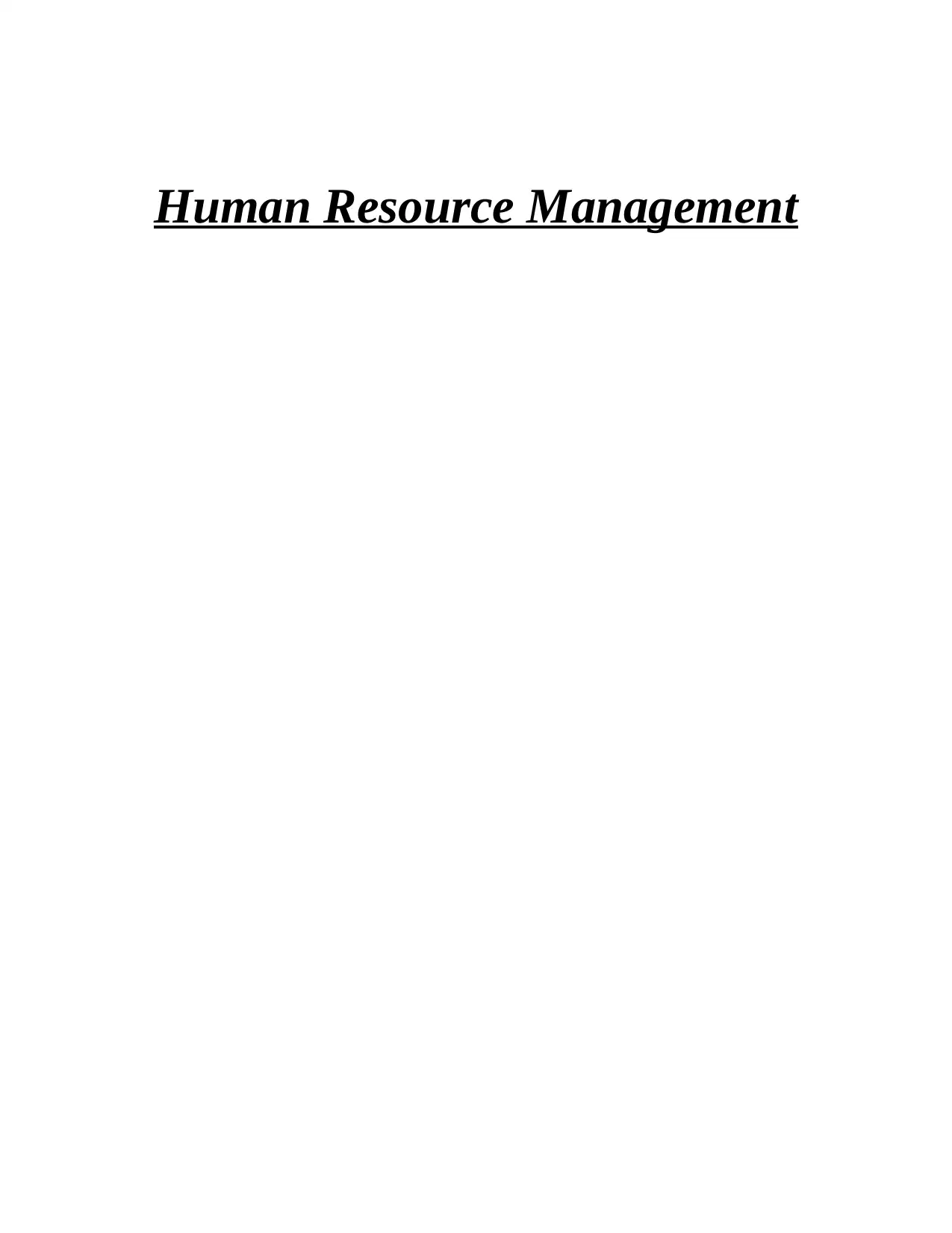
Human Resource Management
Paraphrase This Document
Need a fresh take? Get an instant paraphrase of this document with our AI Paraphraser
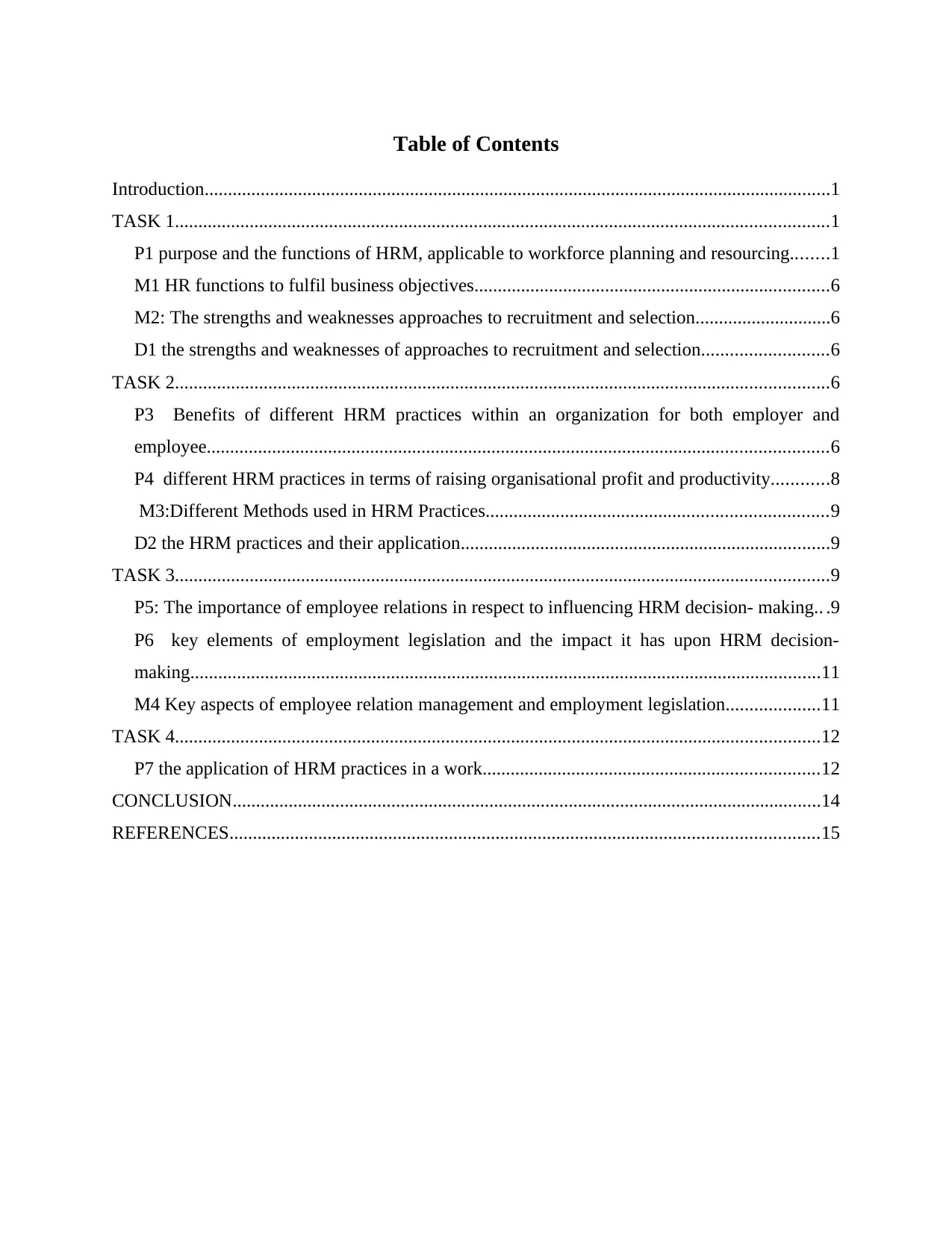
Table of Contents
Introduction......................................................................................................................................1
TASK 1............................................................................................................................................1
P1 purpose and the functions of HRM, applicable to workforce planning and resourcing........1
M1 HR functions to fulfil business objectives............................................................................6
M2: The strengths and weaknesses approaches to recruitment and selection.............................6
D1 the strengths and weaknesses of approaches to recruitment and selection...........................6
TASK 2............................................................................................................................................6
P3 Benefits of different HRM practices within an organization for both employer and
employee.....................................................................................................................................6
P4 different HRM practices in terms of raising organisational profit and productivity............8
M3:Different Methods used in HRM Practices.........................................................................9
D2 the HRM practices and their application...............................................................................9
TASK 3............................................................................................................................................9
P5: The importance of employee relations in respect to influencing HRM decision- making.. .9
P6 key elements of employment legislation and the impact it has upon HRM decision-
making.......................................................................................................................................11
M4 Key aspects of employee relation management and employment legislation....................11
TASK 4..........................................................................................................................................12
P7 the application of HRM practices in a work........................................................................12
CONCLUSION..............................................................................................................................14
REFERENCES..............................................................................................................................15
Introduction......................................................................................................................................1
TASK 1............................................................................................................................................1
P1 purpose and the functions of HRM, applicable to workforce planning and resourcing........1
M1 HR functions to fulfil business objectives............................................................................6
M2: The strengths and weaknesses approaches to recruitment and selection.............................6
D1 the strengths and weaknesses of approaches to recruitment and selection...........................6
TASK 2............................................................................................................................................6
P3 Benefits of different HRM practices within an organization for both employer and
employee.....................................................................................................................................6
P4 different HRM practices in terms of raising organisational profit and productivity............8
M3:Different Methods used in HRM Practices.........................................................................9
D2 the HRM practices and their application...............................................................................9
TASK 3............................................................................................................................................9
P5: The importance of employee relations in respect to influencing HRM decision- making.. .9
P6 key elements of employment legislation and the impact it has upon HRM decision-
making.......................................................................................................................................11
M4 Key aspects of employee relation management and employment legislation....................11
TASK 4..........................................................................................................................................12
P7 the application of HRM practices in a work........................................................................12
CONCLUSION..............................................................................................................................14
REFERENCES..............................................................................................................................15

⊘ This is a preview!⊘
Do you want full access?
Subscribe today to unlock all pages.

Trusted by 1+ million students worldwide
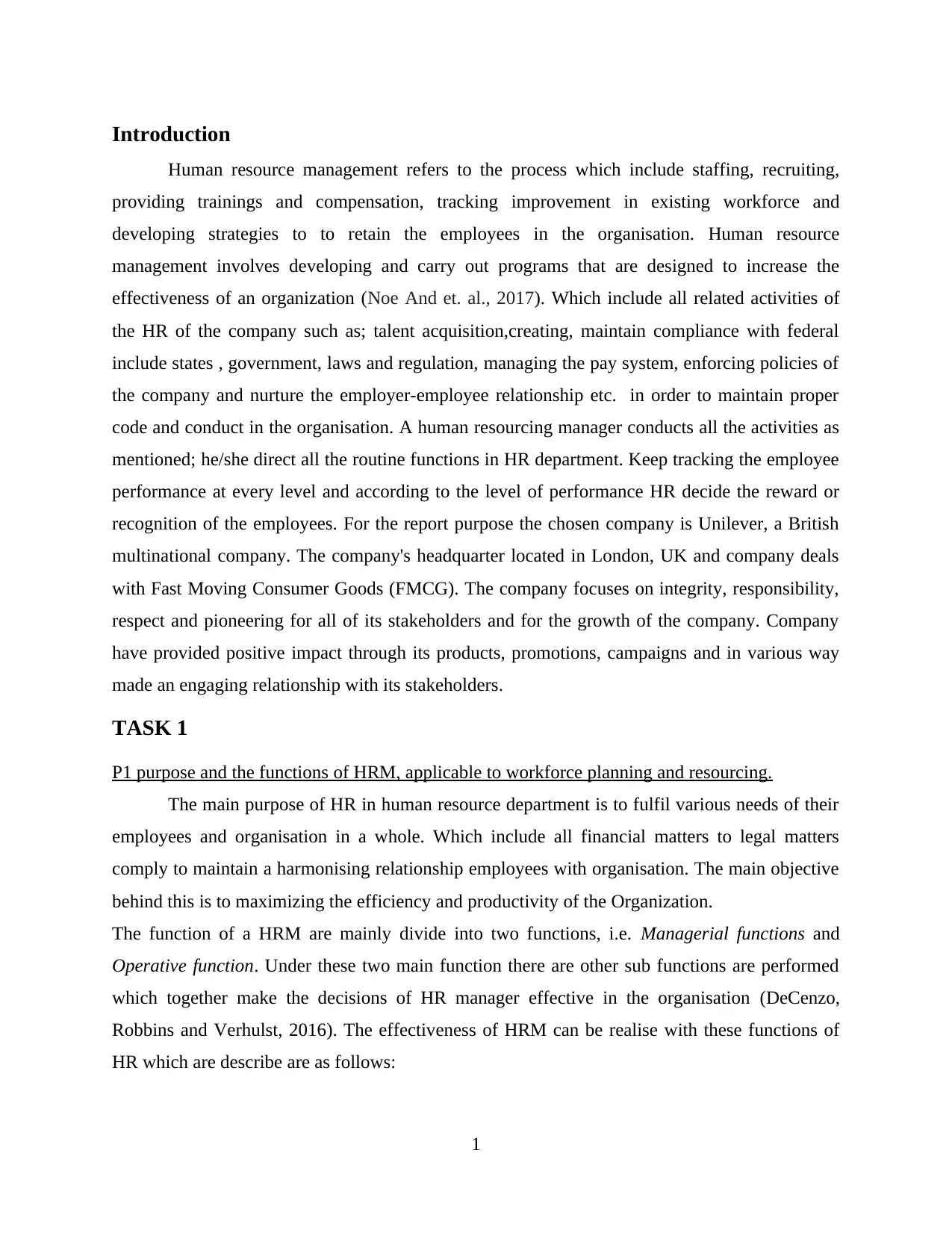
Introduction
Human resource management refers to the process which include staffing, recruiting,
providing trainings and compensation, tracking improvement in existing workforce and
developing strategies to to retain the employees in the organisation. Human resource
management involves developing and carry out programs that are designed to increase the
effectiveness of an organization (Noe And et. al., 2017). Which include all related activities of
the HR of the company such as; talent acquisition,creating, maintain compliance with federal
include states , government, laws and regulation, managing the pay system, enforcing policies of
the company and nurture the employer-employee relationship etc. in order to maintain proper
code and conduct in the organisation. A human resourcing manager conducts all the activities as
mentioned; he/she direct all the routine functions in HR department. Keep tracking the employee
performance at every level and according to the level of performance HR decide the reward or
recognition of the employees. For the report purpose the chosen company is Unilever, a British
multinational company. The company's headquarter located in London, UK and company deals
with Fast Moving Consumer Goods (FMCG). The company focuses on integrity, responsibility,
respect and pioneering for all of its stakeholders and for the growth of the company. Company
have provided positive impact through its products, promotions, campaigns and in various way
made an engaging relationship with its stakeholders.
TASK 1
P1 purpose and the functions of HRM, applicable to workforce planning and resourcing.
The main purpose of HR in human resource department is to fulfil various needs of their
employees and organisation in a whole. Which include all financial matters to legal matters
comply to maintain a harmonising relationship employees with organisation. The main objective
behind this is to maximizing the efficiency and productivity of the Organization.
The function of a HRM are mainly divide into two functions, i.e. Managerial functions and
Operative function. Under these two main function there are other sub functions are performed
which together make the decisions of HR manager effective in the organisation (DeCenzo,
Robbins and Verhulst, 2016). The effectiveness of HRM can be realise with these functions of
HR which are describe are as follows:
1
Human resource management refers to the process which include staffing, recruiting,
providing trainings and compensation, tracking improvement in existing workforce and
developing strategies to to retain the employees in the organisation. Human resource
management involves developing and carry out programs that are designed to increase the
effectiveness of an organization (Noe And et. al., 2017). Which include all related activities of
the HR of the company such as; talent acquisition,creating, maintain compliance with federal
include states , government, laws and regulation, managing the pay system, enforcing policies of
the company and nurture the employer-employee relationship etc. in order to maintain proper
code and conduct in the organisation. A human resourcing manager conducts all the activities as
mentioned; he/she direct all the routine functions in HR department. Keep tracking the employee
performance at every level and according to the level of performance HR decide the reward or
recognition of the employees. For the report purpose the chosen company is Unilever, a British
multinational company. The company's headquarter located in London, UK and company deals
with Fast Moving Consumer Goods (FMCG). The company focuses on integrity, responsibility,
respect and pioneering for all of its stakeholders and for the growth of the company. Company
have provided positive impact through its products, promotions, campaigns and in various way
made an engaging relationship with its stakeholders.
TASK 1
P1 purpose and the functions of HRM, applicable to workforce planning and resourcing.
The main purpose of HR in human resource department is to fulfil various needs of their
employees and organisation in a whole. Which include all financial matters to legal matters
comply to maintain a harmonising relationship employees with organisation. The main objective
behind this is to maximizing the efficiency and productivity of the Organization.
The function of a HRM are mainly divide into two functions, i.e. Managerial functions and
Operative function. Under these two main function there are other sub functions are performed
which together make the decisions of HR manager effective in the organisation (DeCenzo,
Robbins and Verhulst, 2016). The effectiveness of HRM can be realise with these functions of
HR which are describe are as follows:
1
Paraphrase This Document
Need a fresh take? Get an instant paraphrase of this document with our AI Paraphraser
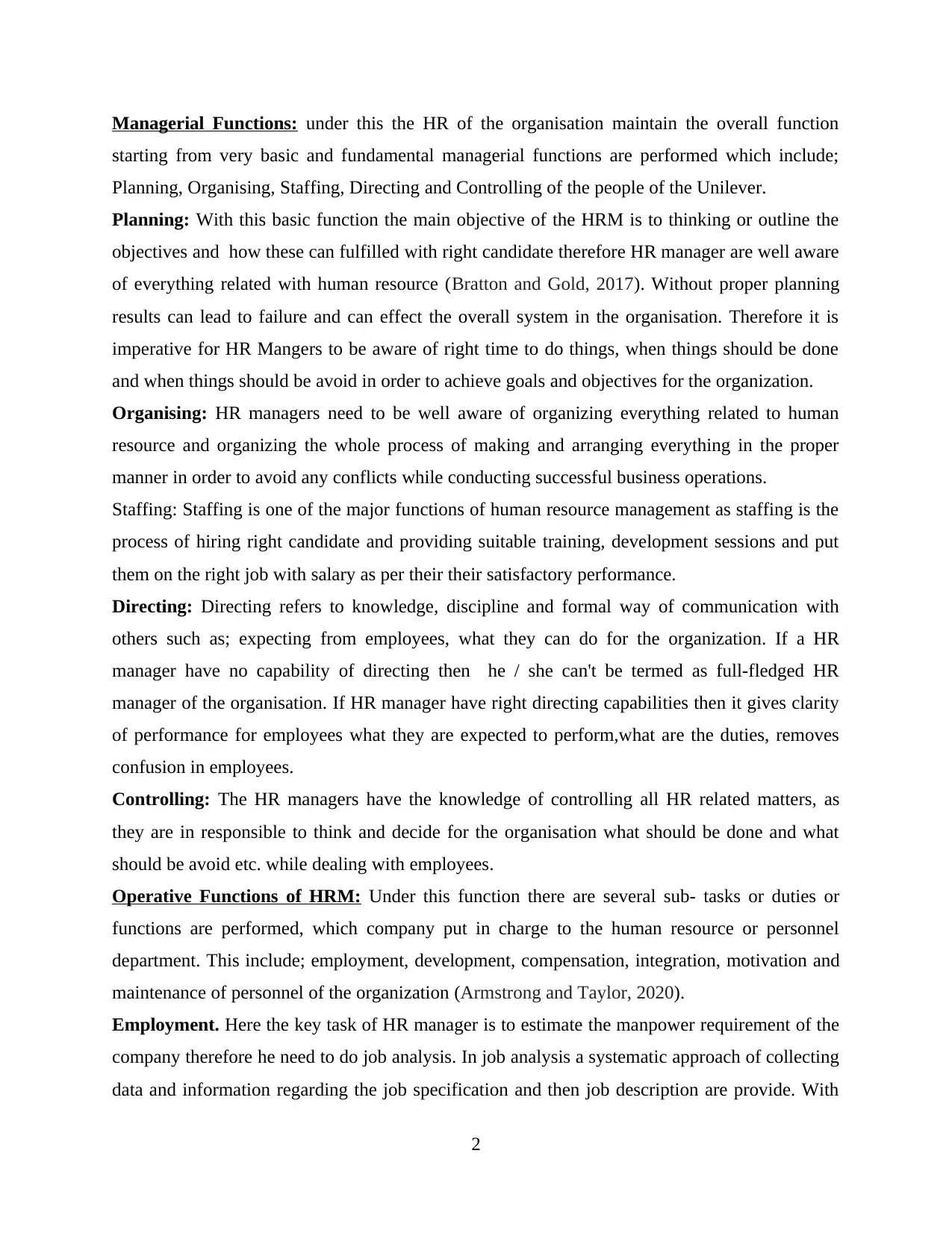
Managerial Functions: under this the HR of the organisation maintain the overall function
starting from very basic and fundamental managerial functions are performed which include;
Planning, Organising, Staffing, Directing and Controlling of the people of the Unilever.
Planning: With this basic function the main objective of the HRM is to thinking or outline the
objectives and how these can fulfilled with right candidate therefore HR manager are well aware
of everything related with human resource (Bratton and Gold, 2017). Without proper planning
results can lead to failure and can effect the overall system in the organisation. Therefore it is
imperative for HR Mangers to be aware of right time to do things, when things should be done
and when things should be avoid in order to achieve goals and objectives for the organization.
Organising: HR managers need to be well aware of organizing everything related to human
resource and organizing the whole process of making and arranging everything in the proper
manner in order to avoid any conflicts while conducting successful business operations.
Staffing: Staffing is one of the major functions of human resource management as staffing is the
process of hiring right candidate and providing suitable training, development sessions and put
them on the right job with salary as per their their satisfactory performance.
Directing: Directing refers to knowledge, discipline and formal way of communication with
others such as; expecting from employees, what they can do for the organization. If a HR
manager have no capability of directing then he / she can't be termed as full-fledged HR
manager of the organisation. If HR manager have right directing capabilities then it gives clarity
of performance for employees what they are expected to perform,what are the duties, removes
confusion in employees.
Controlling: The HR managers have the knowledge of controlling all HR related matters, as
they are in responsible to think and decide for the organisation what should be done and what
should be avoid etc. while dealing with employees.
Operative Functions of HRM: Under this function there are several sub- tasks or duties or
functions are performed, which company put in charge to the human resource or personnel
department. This include; employment, development, compensation, integration, motivation and
maintenance of personnel of the organization (Armstrong and Taylor, 2020).
Employment. Here the key task of HR manager is to estimate the manpower requirement of the
company therefore he need to do job analysis. In job analysis a systematic approach of collecting
data and information regarding the job specification and then job description are provide. With
2
starting from very basic and fundamental managerial functions are performed which include;
Planning, Organising, Staffing, Directing and Controlling of the people of the Unilever.
Planning: With this basic function the main objective of the HRM is to thinking or outline the
objectives and how these can fulfilled with right candidate therefore HR manager are well aware
of everything related with human resource (Bratton and Gold, 2017). Without proper planning
results can lead to failure and can effect the overall system in the organisation. Therefore it is
imperative for HR Mangers to be aware of right time to do things, when things should be done
and when things should be avoid in order to achieve goals and objectives for the organization.
Organising: HR managers need to be well aware of organizing everything related to human
resource and organizing the whole process of making and arranging everything in the proper
manner in order to avoid any conflicts while conducting successful business operations.
Staffing: Staffing is one of the major functions of human resource management as staffing is the
process of hiring right candidate and providing suitable training, development sessions and put
them on the right job with salary as per their their satisfactory performance.
Directing: Directing refers to knowledge, discipline and formal way of communication with
others such as; expecting from employees, what they can do for the organization. If a HR
manager have no capability of directing then he / she can't be termed as full-fledged HR
manager of the organisation. If HR manager have right directing capabilities then it gives clarity
of performance for employees what they are expected to perform,what are the duties, removes
confusion in employees.
Controlling: The HR managers have the knowledge of controlling all HR related matters, as
they are in responsible to think and decide for the organisation what should be done and what
should be avoid etc. while dealing with employees.
Operative Functions of HRM: Under this function there are several sub- tasks or duties or
functions are performed, which company put in charge to the human resource or personnel
department. This include; employment, development, compensation, integration, motivation and
maintenance of personnel of the organization (Armstrong and Taylor, 2020).
Employment. Here the key task of HR manager is to estimate the manpower requirement of the
company therefore he need to do job analysis. In job analysis a systematic approach of collecting
data and information regarding the job specification and then job description are provide. With
2
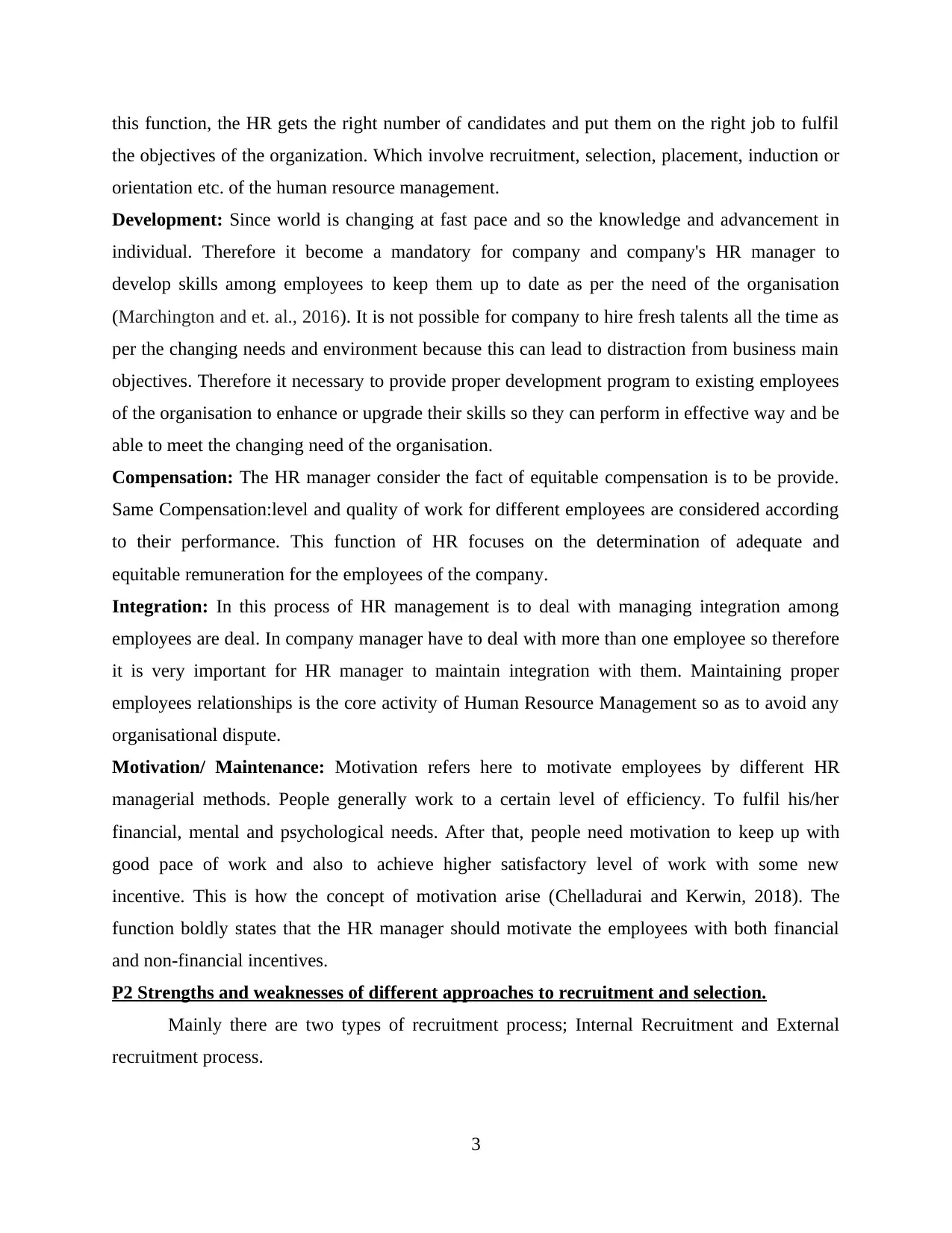
this function, the HR gets the right number of candidates and put them on the right job to fulfil
the objectives of the organization. Which involve recruitment, selection, placement, induction or
orientation etc. of the human resource management.
Development: Since world is changing at fast pace and so the knowledge and advancement in
individual. Therefore it become a mandatory for company and company's HR manager to
develop skills among employees to keep them up to date as per the need of the organisation
(Marchington and et. al., 2016). It is not possible for company to hire fresh talents all the time as
per the changing needs and environment because this can lead to distraction from business main
objectives. Therefore it necessary to provide proper development program to existing employees
of the organisation to enhance or upgrade their skills so they can perform in effective way and be
able to meet the changing need of the organisation.
Compensation: The HR manager consider the fact of equitable compensation is to be provide.
Same Compensation:level and quality of work for different employees are considered according
to their performance. This function of HR focuses on the determination of adequate and
equitable remuneration for the employees of the company.
Integration: In this process of HR management is to deal with managing integration among
employees are deal. In company manager have to deal with more than one employee so therefore
it is very important for HR manager to maintain integration with them. Maintaining proper
employees relationships is the core activity of Human Resource Management so as to avoid any
organisational dispute.
Motivation/ Maintenance: Motivation refers here to motivate employees by different HR
managerial methods. People generally work to a certain level of efficiency. To fulfil his/her
financial, mental and psychological needs. After that, people need motivation to keep up with
good pace of work and also to achieve higher satisfactory level of work with some new
incentive. This is how the concept of motivation arise (Chelladurai and Kerwin, 2018). The
function boldly states that the HR manager should motivate the employees with both financial
and non-financial incentives.
P2 Strengths and weaknesses of different approaches to recruitment and selection.
Mainly there are two types of recruitment process; Internal Recruitment and External
recruitment process.
3
the objectives of the organization. Which involve recruitment, selection, placement, induction or
orientation etc. of the human resource management.
Development: Since world is changing at fast pace and so the knowledge and advancement in
individual. Therefore it become a mandatory for company and company's HR manager to
develop skills among employees to keep them up to date as per the need of the organisation
(Marchington and et. al., 2016). It is not possible for company to hire fresh talents all the time as
per the changing needs and environment because this can lead to distraction from business main
objectives. Therefore it necessary to provide proper development program to existing employees
of the organisation to enhance or upgrade their skills so they can perform in effective way and be
able to meet the changing need of the organisation.
Compensation: The HR manager consider the fact of equitable compensation is to be provide.
Same Compensation:level and quality of work for different employees are considered according
to their performance. This function of HR focuses on the determination of adequate and
equitable remuneration for the employees of the company.
Integration: In this process of HR management is to deal with managing integration among
employees are deal. In company manager have to deal with more than one employee so therefore
it is very important for HR manager to maintain integration with them. Maintaining proper
employees relationships is the core activity of Human Resource Management so as to avoid any
organisational dispute.
Motivation/ Maintenance: Motivation refers here to motivate employees by different HR
managerial methods. People generally work to a certain level of efficiency. To fulfil his/her
financial, mental and psychological needs. After that, people need motivation to keep up with
good pace of work and also to achieve higher satisfactory level of work with some new
incentive. This is how the concept of motivation arise (Chelladurai and Kerwin, 2018). The
function boldly states that the HR manager should motivate the employees with both financial
and non-financial incentives.
P2 Strengths and weaknesses of different approaches to recruitment and selection.
Mainly there are two types of recruitment process; Internal Recruitment and External
recruitment process.
3
⊘ This is a preview!⊘
Do you want full access?
Subscribe today to unlock all pages.

Trusted by 1+ million students worldwide
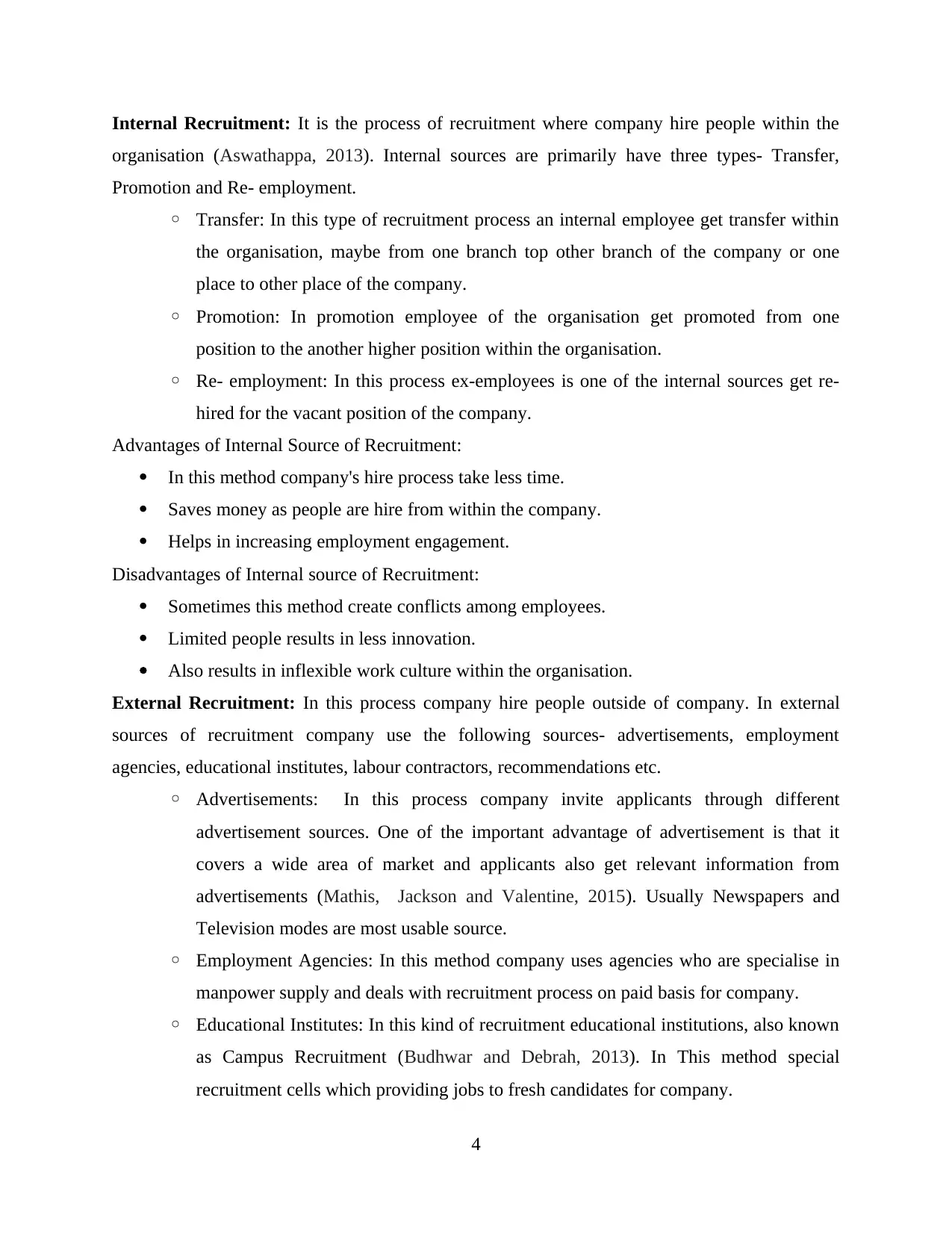
Internal Recruitment: It is the process of recruitment where company hire people within the
organisation (Aswathappa, 2013). Internal sources are primarily have three types- Transfer,
Promotion and Re- employment.
◦ Transfer: In this type of recruitment process an internal employee get transfer within
the organisation, maybe from one branch top other branch of the company or one
place to other place of the company.
◦ Promotion: In promotion employee of the organisation get promoted from one
position to the another higher position within the organisation.
◦ Re- employment: In this process ex-employees is one of the internal sources get re-
hired for the vacant position of the company.
Advantages of Internal Source of Recruitment:
In this method company's hire process take less time.
Saves money as people are hire from within the company.
Helps in increasing employment engagement.
Disadvantages of Internal source of Recruitment:
Sometimes this method create conflicts among employees.
Limited people results in less innovation.
Also results in inflexible work culture within the organisation.
External Recruitment: In this process company hire people outside of company. In external
sources of recruitment company use the following sources- advertisements, employment
agencies, educational institutes, labour contractors, recommendations etc.
◦ Advertisements: In this process company invite applicants through different
advertisement sources. One of the important advantage of advertisement is that it
covers a wide area of market and applicants also get relevant information from
advertisements (Mathis, Jackson and Valentine, 2015). Usually Newspapers and
Television modes are most usable source.
◦ Employment Agencies: In this method company uses agencies who are specialise in
manpower supply and deals with recruitment process on paid basis for company.
◦ Educational Institutes: In this kind of recruitment educational institutions, also known
as Campus Recruitment (Budhwar and Debrah, 2013). In This method special
recruitment cells which providing jobs to fresh candidates for company.
4
organisation (Aswathappa, 2013). Internal sources are primarily have three types- Transfer,
Promotion and Re- employment.
◦ Transfer: In this type of recruitment process an internal employee get transfer within
the organisation, maybe from one branch top other branch of the company or one
place to other place of the company.
◦ Promotion: In promotion employee of the organisation get promoted from one
position to the another higher position within the organisation.
◦ Re- employment: In this process ex-employees is one of the internal sources get re-
hired for the vacant position of the company.
Advantages of Internal Source of Recruitment:
In this method company's hire process take less time.
Saves money as people are hire from within the company.
Helps in increasing employment engagement.
Disadvantages of Internal source of Recruitment:
Sometimes this method create conflicts among employees.
Limited people results in less innovation.
Also results in inflexible work culture within the organisation.
External Recruitment: In this process company hire people outside of company. In external
sources of recruitment company use the following sources- advertisements, employment
agencies, educational institutes, labour contractors, recommendations etc.
◦ Advertisements: In this process company invite applicants through different
advertisement sources. One of the important advantage of advertisement is that it
covers a wide area of market and applicants also get relevant information from
advertisements (Mathis, Jackson and Valentine, 2015). Usually Newspapers and
Television modes are most usable source.
◦ Employment Agencies: In this method company uses agencies who are specialise in
manpower supply and deals with recruitment process on paid basis for company.
◦ Educational Institutes: In this kind of recruitment educational institutions, also known
as Campus Recruitment (Budhwar and Debrah, 2013). In This method special
recruitment cells which providing jobs to fresh candidates for company.
4
Paraphrase This Document
Need a fresh take? Get an instant paraphrase of this document with our AI Paraphraser
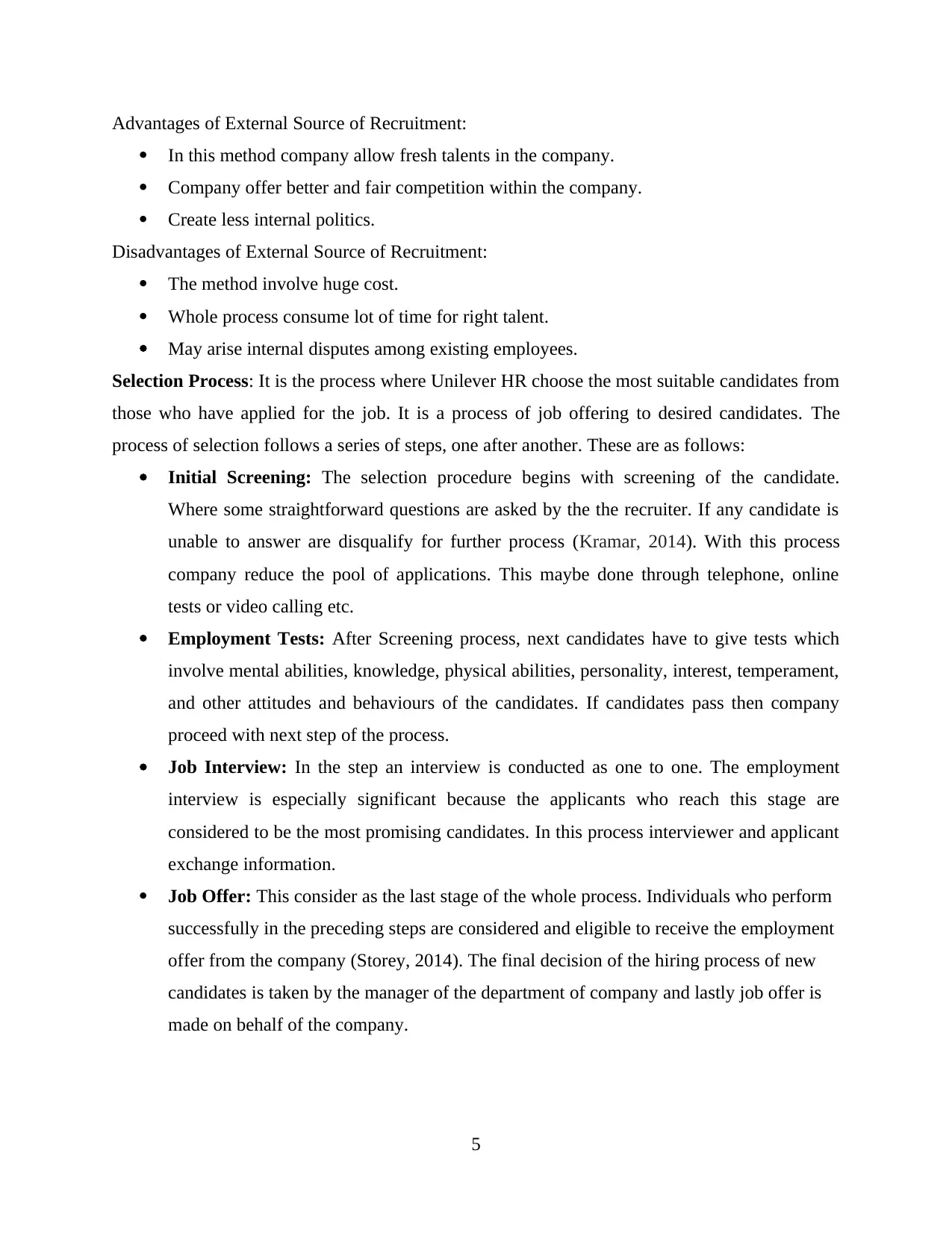
Advantages of External Source of Recruitment:
In this method company allow fresh talents in the company.
Company offer better and fair competition within the company.
Create less internal politics.
Disadvantages of External Source of Recruitment:
The method involve huge cost.
Whole process consume lot of time for right talent.
May arise internal disputes among existing employees.
Selection Process: It is the process where Unilever HR choose the most suitable candidates from
those who have applied for the job. It is a process of job offering to desired candidates. The
process of selection follows a series of steps, one after another. These are as follows:
Initial Screening: The selection procedure begins with screening of the candidate.
Where some straightforward questions are asked by the the recruiter. If any candidate is
unable to answer are disqualify for further process (Kramar, 2014). With this process
company reduce the pool of applications. This maybe done through telephone, online
tests or video calling etc.
Employment Tests: After Screening process, next candidates have to give tests which
involve mental abilities, knowledge, physical abilities, personality, interest, temperament,
and other attitudes and behaviours of the candidates. If candidates pass then company
proceed with next step of the process.
Job Interview: In the step an interview is conducted as one to one. The employment
interview is especially significant because the applicants who reach this stage are
considered to be the most promising candidates. In this process interviewer and applicant
exchange information.
Job Offer: This consider as the last stage of the whole process. Individuals who perform
successfully in the preceding steps are considered and eligible to receive the employment
offer from the company (Storey, 2014). The final decision of the hiring process of new
candidates is taken by the manager of the department of company and lastly job offer is
made on behalf of the company.
5
In this method company allow fresh talents in the company.
Company offer better and fair competition within the company.
Create less internal politics.
Disadvantages of External Source of Recruitment:
The method involve huge cost.
Whole process consume lot of time for right talent.
May arise internal disputes among existing employees.
Selection Process: It is the process where Unilever HR choose the most suitable candidates from
those who have applied for the job. It is a process of job offering to desired candidates. The
process of selection follows a series of steps, one after another. These are as follows:
Initial Screening: The selection procedure begins with screening of the candidate.
Where some straightforward questions are asked by the the recruiter. If any candidate is
unable to answer are disqualify for further process (Kramar, 2014). With this process
company reduce the pool of applications. This maybe done through telephone, online
tests or video calling etc.
Employment Tests: After Screening process, next candidates have to give tests which
involve mental abilities, knowledge, physical abilities, personality, interest, temperament,
and other attitudes and behaviours of the candidates. If candidates pass then company
proceed with next step of the process.
Job Interview: In the step an interview is conducted as one to one. The employment
interview is especially significant because the applicants who reach this stage are
considered to be the most promising candidates. In this process interviewer and applicant
exchange information.
Job Offer: This consider as the last stage of the whole process. Individuals who perform
successfully in the preceding steps are considered and eligible to receive the employment
offer from the company (Storey, 2014). The final decision of the hiring process of new
candidates is taken by the manager of the department of company and lastly job offer is
made on behalf of the company.
5
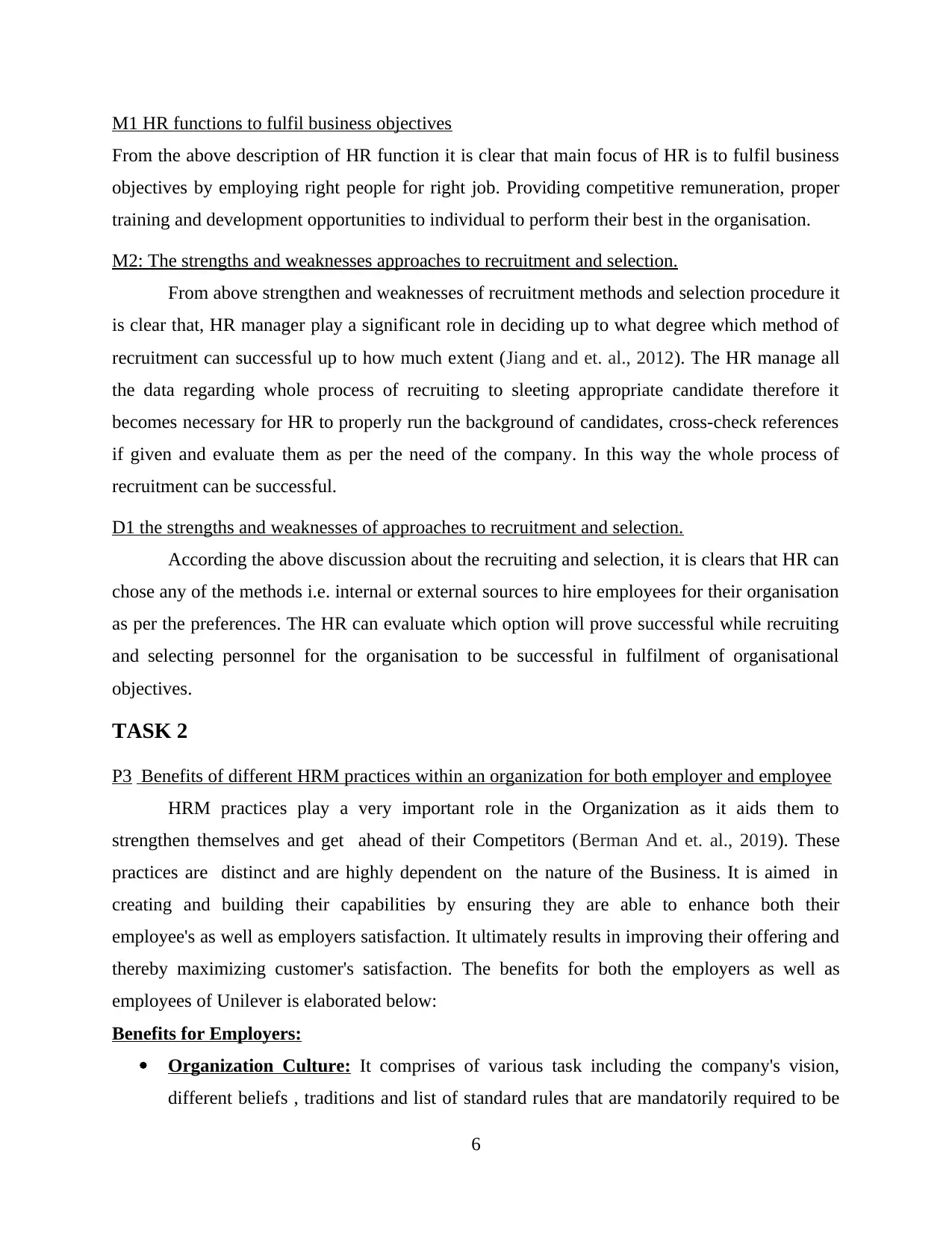
M1 HR functions to fulfil business objectives
From the above description of HR function it is clear that main focus of HR is to fulfil business
objectives by employing right people for right job. Providing competitive remuneration, proper
training and development opportunities to individual to perform their best in the organisation.
M2: The strengths and weaknesses approaches to recruitment and selection.
From above strengthen and weaknesses of recruitment methods and selection procedure it
is clear that, HR manager play a significant role in deciding up to what degree which method of
recruitment can successful up to how much extent (Jiang and et. al., 2012). The HR manage all
the data regarding whole process of recruiting to sleeting appropriate candidate therefore it
becomes necessary for HR to properly run the background of candidates, cross-check references
if given and evaluate them as per the need of the company. In this way the whole process of
recruitment can be successful.
D1 the strengths and weaknesses of approaches to recruitment and selection.
According the above discussion about the recruiting and selection, it is clears that HR can
chose any of the methods i.e. internal or external sources to hire employees for their organisation
as per the preferences. The HR can evaluate which option will prove successful while recruiting
and selecting personnel for the organisation to be successful in fulfilment of organisational
objectives.
TASK 2
P3 Benefits of different HRM practices within an organization for both employer and employee
HRM practices play a very important role in the Organization as it aids them to
strengthen themselves and get ahead of their Competitors (Berman And et. al., 2019). These
practices are distinct and are highly dependent on the nature of the Business. It is aimed in
creating and building their capabilities by ensuring they are able to enhance both their
employee's as well as employers satisfaction. It ultimately results in improving their offering and
thereby maximizing customer's satisfaction. The benefits for both the employers as well as
employees of Unilever is elaborated below:
Benefits for Employers:
Organization Culture: It comprises of various task including the company's vision,
different beliefs , traditions and list of standard rules that are mandatorily required to be
6
From the above description of HR function it is clear that main focus of HR is to fulfil business
objectives by employing right people for right job. Providing competitive remuneration, proper
training and development opportunities to individual to perform their best in the organisation.
M2: The strengths and weaknesses approaches to recruitment and selection.
From above strengthen and weaknesses of recruitment methods and selection procedure it
is clear that, HR manager play a significant role in deciding up to what degree which method of
recruitment can successful up to how much extent (Jiang and et. al., 2012). The HR manage all
the data regarding whole process of recruiting to sleeting appropriate candidate therefore it
becomes necessary for HR to properly run the background of candidates, cross-check references
if given and evaluate them as per the need of the company. In this way the whole process of
recruitment can be successful.
D1 the strengths and weaknesses of approaches to recruitment and selection.
According the above discussion about the recruiting and selection, it is clears that HR can
chose any of the methods i.e. internal or external sources to hire employees for their organisation
as per the preferences. The HR can evaluate which option will prove successful while recruiting
and selecting personnel for the organisation to be successful in fulfilment of organisational
objectives.
TASK 2
P3 Benefits of different HRM practices within an organization for both employer and employee
HRM practices play a very important role in the Organization as it aids them to
strengthen themselves and get ahead of their Competitors (Berman And et. al., 2019). These
practices are distinct and are highly dependent on the nature of the Business. It is aimed in
creating and building their capabilities by ensuring they are able to enhance both their
employee's as well as employers satisfaction. It ultimately results in improving their offering and
thereby maximizing customer's satisfaction. The benefits for both the employers as well as
employees of Unilever is elaborated below:
Benefits for Employers:
Organization Culture: It comprises of various task including the company's vision,
different beliefs , traditions and list of standard rules that are mandatorily required to be
6
⊘ This is a preview!⊘
Do you want full access?
Subscribe today to unlock all pages.

Trusted by 1+ million students worldwide
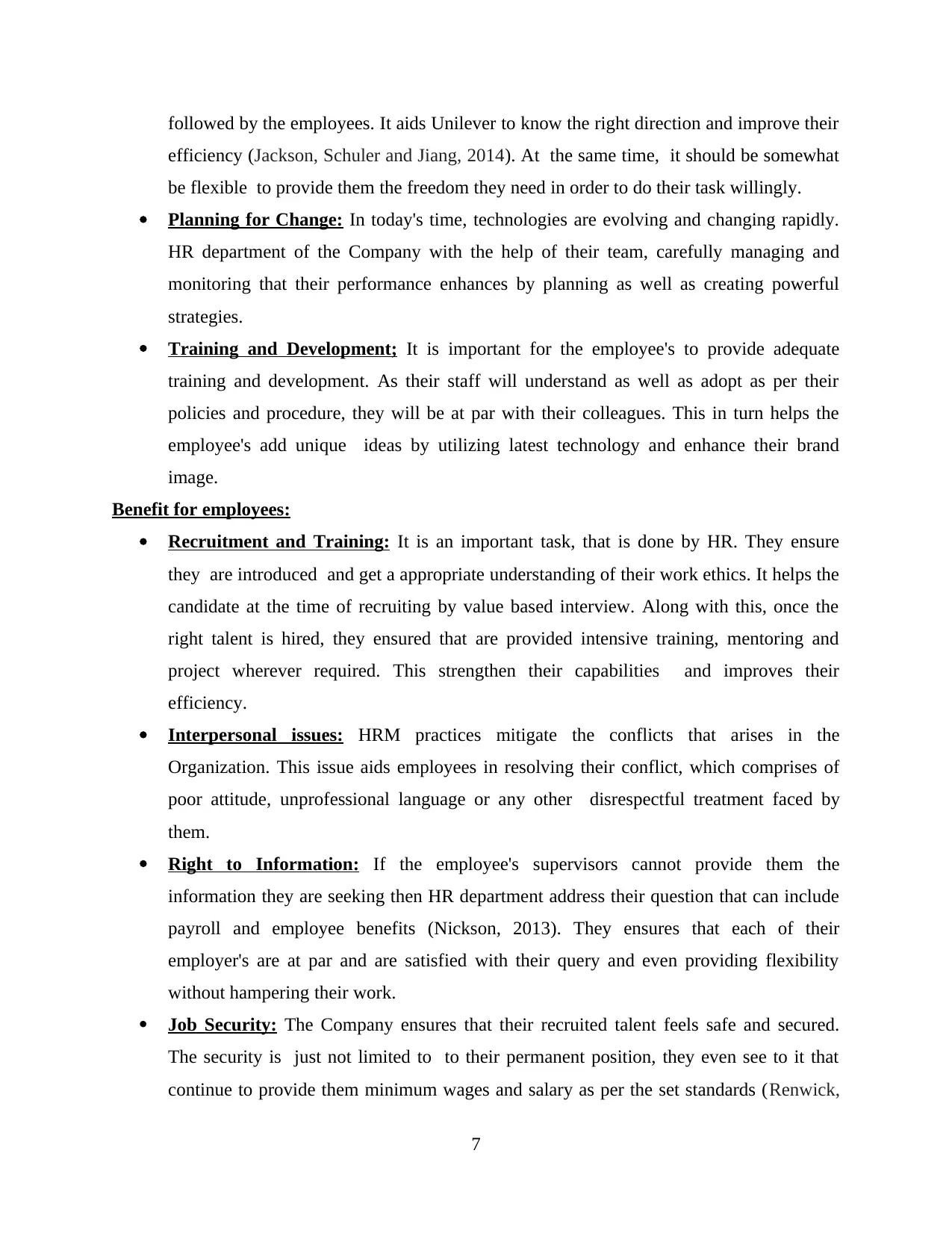
followed by the employees. It aids Unilever to know the right direction and improve their
efficiency (Jackson, Schuler and Jiang, 2014). At the same time, it should be somewhat
be flexible to provide them the freedom they need in order to do their task willingly.
Planning for Change: In today's time, technologies are evolving and changing rapidly.
HR department of the Company with the help of their team, carefully managing and
monitoring that their performance enhances by planning as well as creating powerful
strategies.
Training and Development; It is important for the employee's to provide adequate
training and development. As their staff will understand as well as adopt as per their
policies and procedure, they will be at par with their colleagues. This in turn helps the
employee's add unique ideas by utilizing latest technology and enhance their brand
image.
Benefit for employees:
Recruitment and Training: It is an important task, that is done by HR. They ensure
they are introduced and get a appropriate understanding of their work ethics. It helps the
candidate at the time of recruiting by value based interview. Along with this, once the
right talent is hired, they ensured that are provided intensive training, mentoring and
project wherever required. This strengthen their capabilities and improves their
efficiency.
Interpersonal issues: HRM practices mitigate the conflicts that arises in the
Organization. This issue aids employees in resolving their conflict, which comprises of
poor attitude, unprofessional language or any other disrespectful treatment faced by
them.
Right to Information: If the employee's supervisors cannot provide them the
information they are seeking then HR department address their question that can include
payroll and employee benefits (Nickson, 2013). They ensures that each of their
employer's are at par and are satisfied with their query and even providing flexibility
without hampering their work.
Job Security: The Company ensures that their recruited talent feels safe and secured.
The security is just not limited to to their permanent position, they even see to it that
continue to provide them minimum wages and salary as per the set standards (Renwick,
7
efficiency (Jackson, Schuler and Jiang, 2014). At the same time, it should be somewhat
be flexible to provide them the freedom they need in order to do their task willingly.
Planning for Change: In today's time, technologies are evolving and changing rapidly.
HR department of the Company with the help of their team, carefully managing and
monitoring that their performance enhances by planning as well as creating powerful
strategies.
Training and Development; It is important for the employee's to provide adequate
training and development. As their staff will understand as well as adopt as per their
policies and procedure, they will be at par with their colleagues. This in turn helps the
employee's add unique ideas by utilizing latest technology and enhance their brand
image.
Benefit for employees:
Recruitment and Training: It is an important task, that is done by HR. They ensure
they are introduced and get a appropriate understanding of their work ethics. It helps the
candidate at the time of recruiting by value based interview. Along with this, once the
right talent is hired, they ensured that are provided intensive training, mentoring and
project wherever required. This strengthen their capabilities and improves their
efficiency.
Interpersonal issues: HRM practices mitigate the conflicts that arises in the
Organization. This issue aids employees in resolving their conflict, which comprises of
poor attitude, unprofessional language or any other disrespectful treatment faced by
them.
Right to Information: If the employee's supervisors cannot provide them the
information they are seeking then HR department address their question that can include
payroll and employee benefits (Nickson, 2013). They ensures that each of their
employer's are at par and are satisfied with their query and even providing flexibility
without hampering their work.
Job Security: The Company ensures that their recruited talent feels safe and secured.
The security is just not limited to to their permanent position, they even see to it that
continue to provide them minimum wages and salary as per the set standards (Renwick,
7
Paraphrase This Document
Need a fresh take? Get an instant paraphrase of this document with our AI Paraphraser
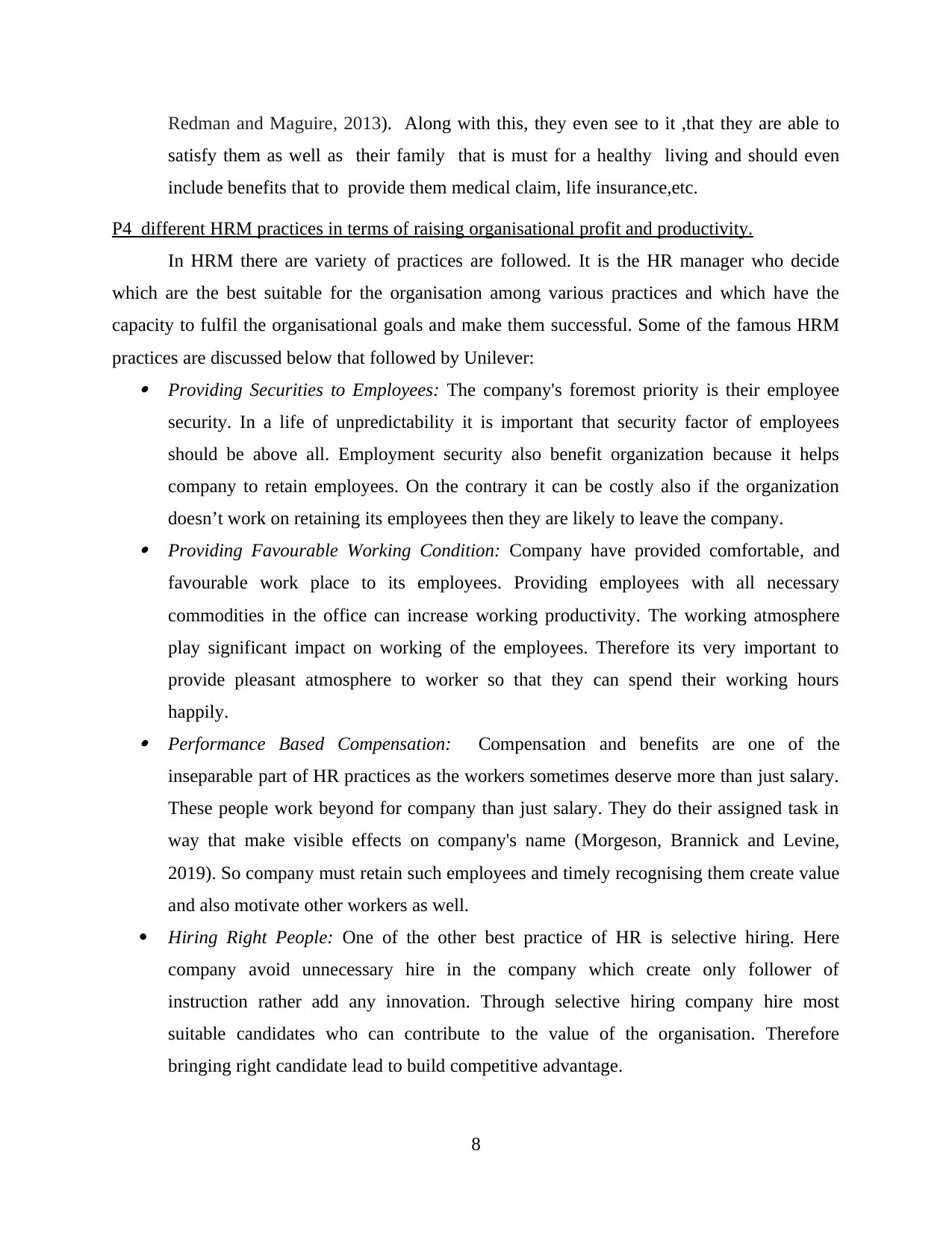
Redman and Maguire, 2013). Along with this, they even see to it ,that they are able to
satisfy them as well as their family that is must for a healthy living and should even
include benefits that to provide them medical claim, life insurance,etc.
P4 different HRM practices in terms of raising organisational profit and productivity.
In HRM there are variety of practices are followed. It is the HR manager who decide
which are the best suitable for the organisation among various practices and which have the
capacity to fulfil the organisational goals and make them successful. Some of the famous HRM
practices are discussed below that followed by Unilever: Providing Securities to Employees: The company's foremost priority is their employee
security. In a life of unpredictability it is important that security factor of employees
should be above all. Employment security also benefit organization because it helps
company to retain employees. On the contrary it can be costly also if the organization
doesn’t work on retaining its employees then they are likely to leave the company. Providing Favourable Working Condition: Company have provided comfortable, and
favourable work place to its employees. Providing employees with all necessary
commodities in the office can increase working productivity. The working atmosphere
play significant impact on working of the employees. Therefore its very important to
provide pleasant atmosphere to worker so that they can spend their working hours
happily. Performance Based Compensation: Compensation and benefits are one of the
inseparable part of HR practices as the workers sometimes deserve more than just salary.
These people work beyond for company than just salary. They do their assigned task in
way that make visible effects on company's name (Morgeson, Brannick and Levine,
2019). So company must retain such employees and timely recognising them create value
and also motivate other workers as well.
Hiring Right People: One of the other best practice of HR is selective hiring. Here
company avoid unnecessary hire in the company which create only follower of
instruction rather add any innovation. Through selective hiring company hire most
suitable candidates who can contribute to the value of the organisation. Therefore
bringing right candidate lead to build competitive advantage.
8
satisfy them as well as their family that is must for a healthy living and should even
include benefits that to provide them medical claim, life insurance,etc.
P4 different HRM practices in terms of raising organisational profit and productivity.
In HRM there are variety of practices are followed. It is the HR manager who decide
which are the best suitable for the organisation among various practices and which have the
capacity to fulfil the organisational goals and make them successful. Some of the famous HRM
practices are discussed below that followed by Unilever: Providing Securities to Employees: The company's foremost priority is their employee
security. In a life of unpredictability it is important that security factor of employees
should be above all. Employment security also benefit organization because it helps
company to retain employees. On the contrary it can be costly also if the organization
doesn’t work on retaining its employees then they are likely to leave the company. Providing Favourable Working Condition: Company have provided comfortable, and
favourable work place to its employees. Providing employees with all necessary
commodities in the office can increase working productivity. The working atmosphere
play significant impact on working of the employees. Therefore its very important to
provide pleasant atmosphere to worker so that they can spend their working hours
happily. Performance Based Compensation: Compensation and benefits are one of the
inseparable part of HR practices as the workers sometimes deserve more than just salary.
These people work beyond for company than just salary. They do their assigned task in
way that make visible effects on company's name (Morgeson, Brannick and Levine,
2019). So company must retain such employees and timely recognising them create value
and also motivate other workers as well.
Hiring Right People: One of the other best practice of HR is selective hiring. Here
company avoid unnecessary hire in the company which create only follower of
instruction rather add any innovation. Through selective hiring company hire most
suitable candidates who can contribute to the value of the organisation. Therefore
bringing right candidate lead to build competitive advantage.
8
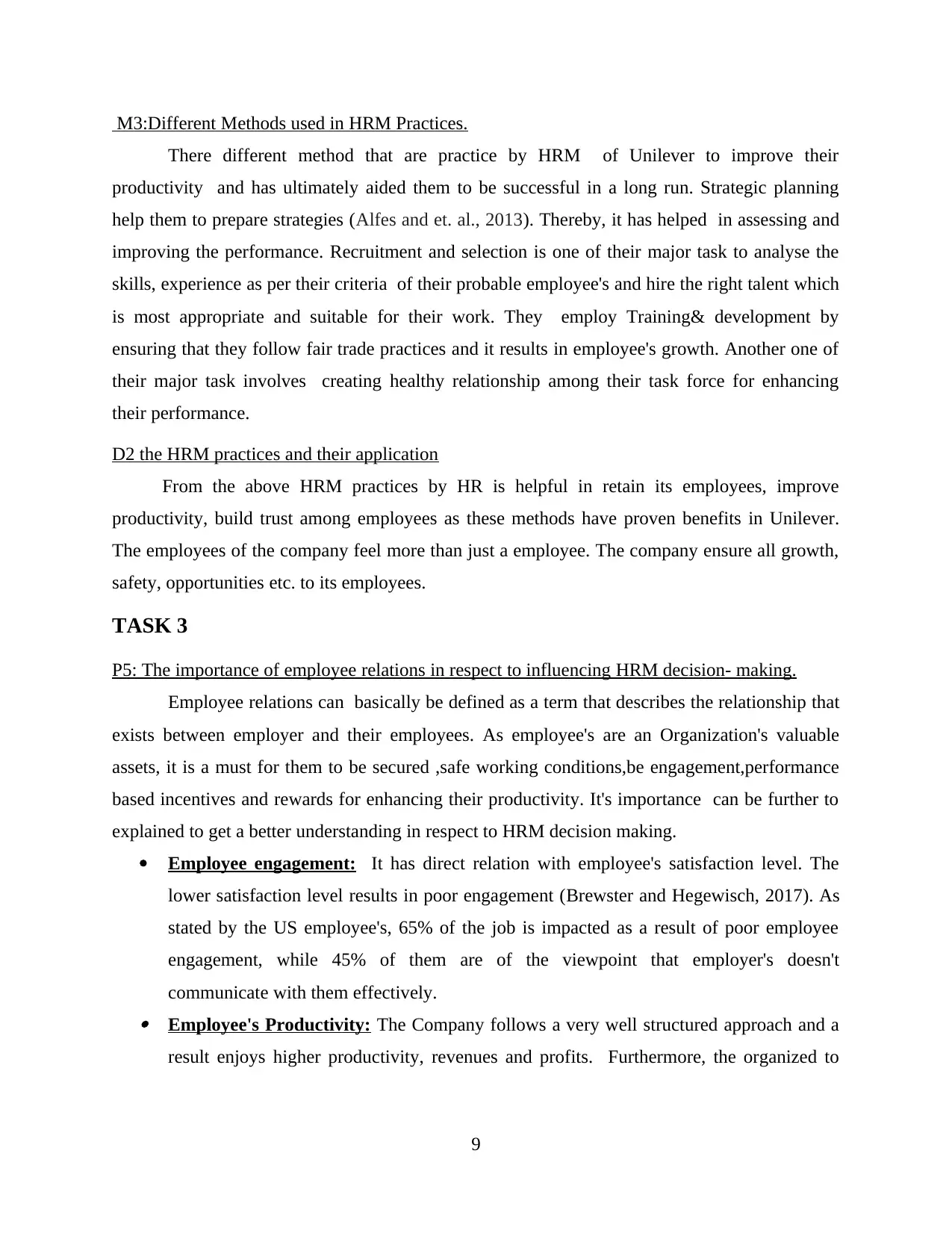
M3:Different Methods used in HRM Practices.
There different method that are practice by HRM of Unilever to improve their
productivity and has ultimately aided them to be successful in a long run. Strategic planning
help them to prepare strategies (Alfes and et. al., 2013). Thereby, it has helped in assessing and
improving the performance. Recruitment and selection is one of their major task to analyse the
skills, experience as per their criteria of their probable employee's and hire the right talent which
is most appropriate and suitable for their work. They employ Training& development by
ensuring that they follow fair trade practices and it results in employee's growth. Another one of
their major task involves creating healthy relationship among their task force for enhancing
their performance.
D2 the HRM practices and their application
From the above HRM practices by HR is helpful in retain its employees, improve
productivity, build trust among employees as these methods have proven benefits in Unilever.
The employees of the company feel more than just a employee. The company ensure all growth,
safety, opportunities etc. to its employees.
TASK 3
P5: The importance of employee relations in respect to influencing HRM decision- making.
Employee relations can basically be defined as a term that describes the relationship that
exists between employer and their employees. As employee's are an Organization's valuable
assets, it is a must for them to be secured ,safe working conditions,be engagement,performance
based incentives and rewards for enhancing their productivity. It's importance can be further to
explained to get a better understanding in respect to HRM decision making.
Employee engagement: It has direct relation with employee's satisfaction level. The
lower satisfaction level results in poor engagement (Brewster and Hegewisch, 2017). As
stated by the US employee's, 65% of the job is impacted as a result of poor employee
engagement, while 45% of them are of the viewpoint that employer's doesn't
communicate with them effectively. Employee's Productivity: The Company follows a very well structured approach and a
result enjoys higher productivity, revenues and profits. Furthermore, the organized to
9
There different method that are practice by HRM of Unilever to improve their
productivity and has ultimately aided them to be successful in a long run. Strategic planning
help them to prepare strategies (Alfes and et. al., 2013). Thereby, it has helped in assessing and
improving the performance. Recruitment and selection is one of their major task to analyse the
skills, experience as per their criteria of their probable employee's and hire the right talent which
is most appropriate and suitable for their work. They employ Training& development by
ensuring that they follow fair trade practices and it results in employee's growth. Another one of
their major task involves creating healthy relationship among their task force for enhancing
their performance.
D2 the HRM practices and their application
From the above HRM practices by HR is helpful in retain its employees, improve
productivity, build trust among employees as these methods have proven benefits in Unilever.
The employees of the company feel more than just a employee. The company ensure all growth,
safety, opportunities etc. to its employees.
TASK 3
P5: The importance of employee relations in respect to influencing HRM decision- making.
Employee relations can basically be defined as a term that describes the relationship that
exists between employer and their employees. As employee's are an Organization's valuable
assets, it is a must for them to be secured ,safe working conditions,be engagement,performance
based incentives and rewards for enhancing their productivity. It's importance can be further to
explained to get a better understanding in respect to HRM decision making.
Employee engagement: It has direct relation with employee's satisfaction level. The
lower satisfaction level results in poor engagement (Brewster and Hegewisch, 2017). As
stated by the US employee's, 65% of the job is impacted as a result of poor employee
engagement, while 45% of them are of the viewpoint that employer's doesn't
communicate with them effectively. Employee's Productivity: The Company follows a very well structured approach and a
result enjoys higher productivity, revenues and profits. Furthermore, the organized to
9
⊘ This is a preview!⊘
Do you want full access?
Subscribe today to unlock all pages.

Trusted by 1+ million students worldwide
1 out of 19
Related Documents
Your All-in-One AI-Powered Toolkit for Academic Success.
+13062052269
info@desklib.com
Available 24*7 on WhatsApp / Email
![[object Object]](/_next/static/media/star-bottom.7253800d.svg)
Unlock your academic potential
Copyright © 2020–2025 A2Z Services. All Rights Reserved. Developed and managed by ZUCOL.





